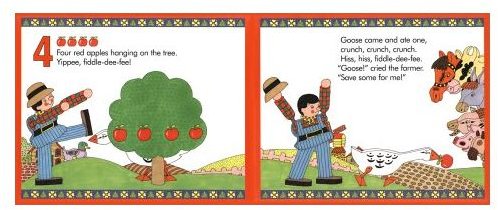Subtract From 10: A Lesson Plan for Kindergarten
Subtraction seems to be a little more difficult than addition for some children. This lesson helps all types of learners understand the concept of subtraction. They will listen, visualize, get up and move to act out the subtraction story and then write it down. Using manipulatives helps tactile learners and keeps everyone engaged in the lesson.
Learning Objectives:
1. Represent addition and subtraction with objects, fingers, mental images, drawings, sounds (e.g., claps), acting out situations, verbal explanations, expressions, or equations.
**
Materials:
- Book: <em>Ten Red Apples</em> by Pat Hutchins
- Ten red apples cut out of construction paper
- Available white board, chalkboard or large chart of paper.
- Ten counters for each child (plastic chips, buttons, goldfish crackers, paperclips or similar)
- Copies of printable worksheet. Each worksheet is good for three students.
- A deck of playing cards (remove the face cards) for each group of four students.
- Scrap paper and pencils for all students.
Lesson Procedure:
Show the students the book Ten Red Apples and tell the students that it is a fiction book, which means it is make-believe. But the counting is real!
Read the book one time through without stopping. Explain to the students that the story shows subtraction, which means that they are taking something away.
Next act out the story. Ten students, each holding a paper apple, will stand in the front of the class. Next assign nine students to be animals: horse, cow, donkey, goat, pig, sheep, goose and hen. Also assign a farmer and perhaps a farmer’s wife. Each time an animal takes an apple ask the students to count the remaining apples.
Now go through the book a third time and call on a student to write the number sentence that represents what you have read. For example, ten apples are on the tree and the horse takes one away. Now there are nine apples remaining.
The student should write 10 – 1 = 9.
Ask students to sit in a large circle on the floor or at their tables/desks. Give each student 10 counters. Instruct the students to put the ten counters in a row in front of them. Then tell them short story problems for which they will use the counters to solve the problem. For example you might say, “ I have ten cookies and I ate two cookies. How many do I have left?” Since the students are probably in the early stages of learning subtraction, physically show them how to move two counters away from the ten counters and then count the remaining. Do this several times until you feel that the students understand the concept.
Follow-Up Activity:
This can be done the same day or the next day depending on your schedule. Students can sit in small groups of four on the floor or at tables. Give each student a strip of the printable subtract from ten game that has the squares from 1-10. Provide ten counters for each student, paper and pencil. The deck of cards goes in the middle face down.
Rules:
- Each student places one marker in each box of his or her paper.
- First person draws a card and takes away that amount of markers from his paper. Start from the 10 and work down as you take away.
- Then he or she writes the number sentence on his paper. You can skip this step but I like to use it for practice writing the equation.
- The next person does the same thing and so on until each player has taken a turn.
- The student who is closest to the number zero wins the round.
Assessment or Homework:
Use the <strong>printable worksheet</strong> that has four subtraction problems for the students to illustrate and solve.
Example: John draws a 5 card. He removes his markers from 10 through 6. He writes on his paper: 10 – 5 = 5
Resources:
Hutchins, Pat. Ten Red Apples. Greenwillow Books, 2000.
Williams, Suzanne. Ten Naughty Little Monkeys. Harper Collins, 2007.
Kaye, Peggy. Games For Math. Pantheon Books, 1987.
